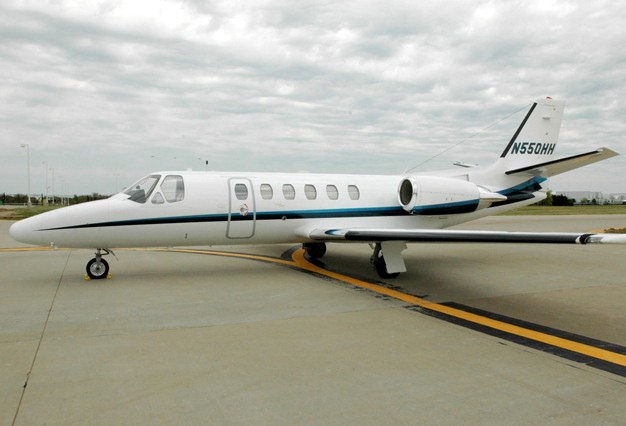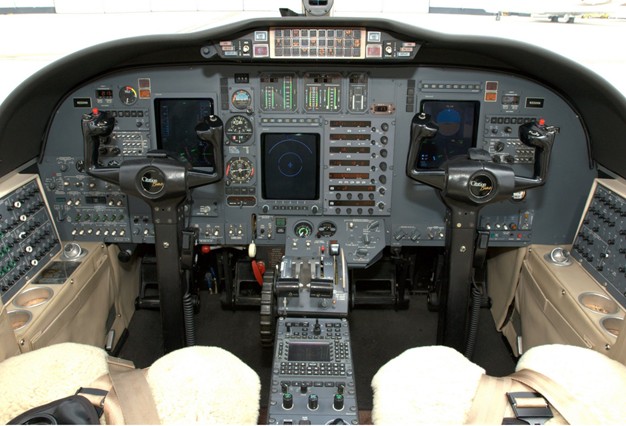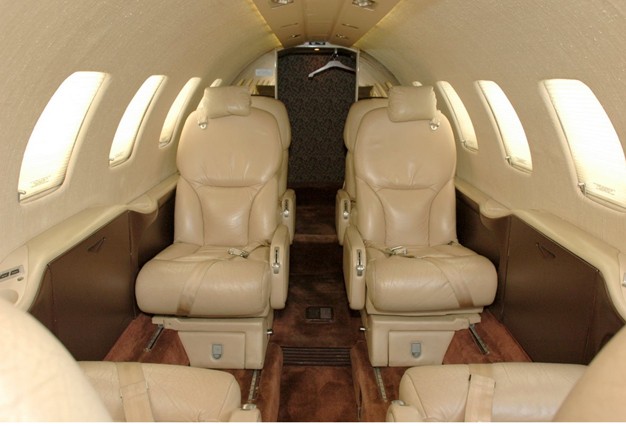


Aircraft Description
One of the features that sets the Citation Bravo apart from the competition is its comfort. The engineers designed the cabin to be very quiet, fitted with bagged insulation and an isolated interior shell to eliminate the low-frequency engine fan noise common in small private jets. Additionally, a secondary seal on the cabin door was added to cut wind noise.
The Bravo has several baggage compartments with a combined capacity of seventy-three cubic feet, or about seven suitcases, four golf bags, and a few sets of skis. There is a convenient compartment beside the cabin lavatory for coats and carry-on items, and all of the seats have storage drawers beneath them.
A frequent complaint that Cessna had received from its clients was the difficulty of boarding its jets. They fixed this problem by widening the airstair treads and adding an additional step to make boarding easier.
The Bravo strikes the perfect balance between performance and cost. It costs the same as its predecessor, the Citation II, but outperforms it by far in climb, cruise, and altitude performance. The Bravo lost 150 pounds of fuel carrying capacity, increased the maximum takeoff weight by 500 pounds, and still manages to burn fewer pounds of fuel per hour.
The increased performance of the Citation Bravo is largely due to the new Pratt & Whitney turbofan engines. At the time of its design, no other light-sized private jets were using the PW530A engines. They burn thirteen percent less fuel than the other engines in the series. Cessna’s engineers saw their potential and used them in the Citation Bravo.
Other updates on the Bravo were designed to aid the crew: easier preflight, servicing and maintenance tasks, and so on. The Bravo is a very easy jet to fly, and pilots can become certified to fly it solo. The majority of the improvements on the Bravo, however, will be hard for passengers to miss.
A landing gear new to the Citation series was added to the Bravo. The gear is the trailing link type, which connects the wheel axel on the landing gear to a gas strut that then links up to the wing. This allows the strut to absorb the loads of landing and taxiing over uneven pavement. In other words, the new main landing gear will make taxiing over uneven pavement and landings extremely smooth.
Cessna put an end to cabin pressurization problems in the Bravo by increasing the pressurization to 9.1 psi and installing a digital pressurization controller. It also equipped the cockpit with systems providing traffic avoidance information, weather radar and digital maps.
If the Citation Bravo’s technical capabilities and passenger offerings aren’t enough, consider its price. Its overall operating cost rivals that of even the best-selling turboprops. When compared to the average cost of other light business jets, it was second only to the CitationJet.
| General | Citation Bravo, CE-550 | |||
|---|---|---|---|---|
| Category | Jet < 20,000 lbs. | |||
| Years Aircraft Manufactured | 1996 – 2006 | |||
| Serial Number Range | 0801-1163 | |||
| Retail High Price | $3,200,000.00 / 2,511,040.00€ | |||
| Retail Low Price | $850,000.00 / 666,995.00€ | |||
| Characteristics | Citation Bravo, CE-550 | |||
| Seating | 2 + 7/8 | |||
| Wing Loading | 45.8 | |||
| Power Loading | 2.6 | |||
| Noise(EPNdB): Takeoff/Sideline/Approach | 73.7/85.2/91.2 | |||
| External Dimensions (ft) | Citation Bravo, CE-550 | |||
| External Length | 47.3 | |||
| External Height | 15.0 | |||
| External Span | 51.8 | |||
| Internal Dimensions (ft) | Citation Bravo, CE-550 | |||
| Internal Length (Overall/Net Height) | 15.8/15.8 | |||
| Internal Height | 4.8 | |||
| Internal Width (Max/Floor) | 4.8/3.2 | |||
| Baggage | Citation Bravo, CE-550 | |||
| External: Cu.Ft./Lb. | 28/300 | |||
| External: Cu.Ft./Lb. | 45/850 | |||
| Power | Citation Bravo, CE-550 | |||
| Engines | 2 P&WC PW530A | |||
| Output (lbs ea.)/Flat Rating | 2,887/ISA+8 | |||
| Inspection Interval | 4,000t | |||
| Data based on latest manufactured year | ||||



